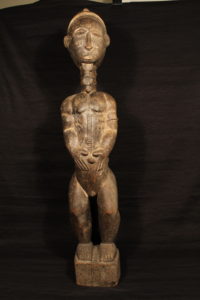Made of wood, this male figure is known as a waka sran by the Baule People of Côte d’Ivoire. Waka sran or Person In Wood are the physical representation of one of three spirit forms. It can be the spirit husband (bolo bian) or spirit wife (bolo bla) of a Baule or less common it could represent a nature spirit (asie usu). All three are represented as beautiful human figures. Once the sculpture is removed from the Baule home it is hard to tell which spirit form the figure was created to represent.
Every Baule has a spirit spouse and when the spirit spouse feels neglected or jealous they can cause trouble in the non-spirit spouse’s marriage or affect their fertility. When this happens, the affected Baule will visit a diviner who can tell them what to do to overcome the trouble in their life. If the trouble is determined to be caused by a jealous or upset spirit spouse, the Baule will be directed to have a figure carved in the likeness of their spirit spouse. The spirit spouse will communicate their features through dreams to either the client, diviner, or sculptor. The spouse is always described as beautiful and their features are aesthetically pleasing and individual. No two are alike.
The asie usu are nature spirits which are found throughout the landscape and can cause illness, poor hunting, and death of animals. A Baule visiting a diviner might learn that their trouble is being caused by a asie usu. They would be told to have a sculpture made to attract the asie usu to settle into the sculpture. Once in the sculpture the Baule would appease the troublesome spirit through offerings. These offerings would allow the Baule to tame the asie usu who would start to use their power to benefit the village.
Our figure could either be a bolo bian or asie usu. It is more likely that it is a bolo bian as they were more common and it does not have a thick patina. Asie usu figures would have been created with a thick patina from the offering made to it over the years. The figure in our collection does not have this thick patina or any evidence of a patina, but that does not mean it once didn’t have a patina. Western collectors would clean off the thick patina and polish the waka sran making it very hard to tell a bolo bian/bla apart from an asie usu. Without having the figure handed to us from the Baule who had it commissioned, it is not possible to say 100% which spirit form we are housing.
The male figure in our collection has typical signs of beauty and respectability found among the Baule. The head is intentionally carved disproportionate to the body as a sign of wisdom. A long, straight, and sturdy neck is recognizable as a sign of positive characteristics like honor, pride, and esteem of others. Shapely calves and buttocks presented in near perfect symmetry are an important part of physical beauty in Baule culture. The raised lines and dots along the back, belly, neck, and cheeks of this spirit form are scarification a form of beautifying ones body. The number of scars and the details such as the band on the left arm and the cap indicate this spirit form was likely an expensive commission and great care was taken in carving him. Most of the African pieces, like this one, in the collection of the Reginald F. Lewis Museum, were meant to be functional in the culture of the African people. However, it is their beauty that has elevated them to works of art.

